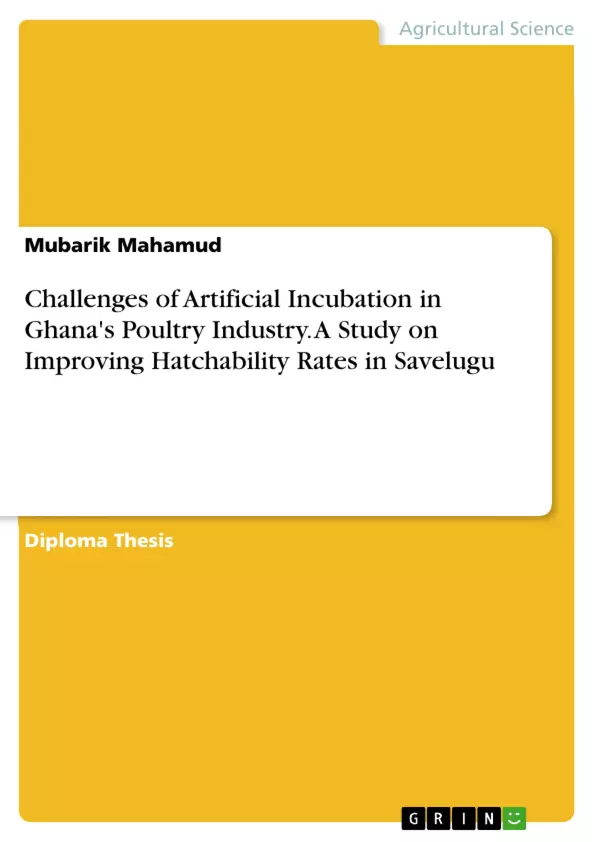The aim of this study was to assess poor hatchability of poultry in Savelugu in the Savelugu municipality of the Northern region, Ghana. The study will adopt the survey design to administer questionnaires to 55 poultry producers to collect relevant data. Data will be analysed using SPSS V26.
The research highlights the significant role of artificial incubation and rearing in aviculture to boost reproductive rates, especially in endangered species. It emphasizes how artificial incubation impacts performance in modern poultry farming, with a focus on quality chicks. Despite advancements in incubator technology, artificial incubation remains a challenge, particularly compared to natural incubation. The study points out how critical factors like temperature, humidity, and egg turning can influence incubation success rates. In Ghana, where the poultry industry contributes significantly to the economy, there is a lack of standardized procedures for producing quality chicks, leading to high mortality rates and low hatchability. This study focuses on Savelugu to gain better understanding of the issue and potential solutions.
Inhaltsverzeichnis (Table of Contents)
-
Chapter one.
- Introduction
- Background to the study
- Problem statement
- Justification
- Research objectives
- Main research objective
- Specific research objectives
- Research questions
- Main research question
- Specific research questions
- Delimitations
- Organization of the thesis
-
Chapter two.
- Literature review
- Introduction
- Poultry production in Ghana
- Artificial incubation
- Two to three days before incubation
- Cleaning and fumigation
- The day eggs are set
- Set stage
- Egg factors causing hatching failure
- Incubator factors causes hatching failure
- Empirical review
- Embryonic Mortality
- Malposition
- Chapter summary
-
Chapter three.
- Methodology
- Introduction
- Study area
- Study design
- Sample size determination
- Sampling technique
- Data collection techniques
- Data sources
- Questionnaire instrumentation
- Data collection procedure
- Data management and statistical analysis
- Ethical considerations
-
Chapter four
- Results and discussion
- Introduction
- Descriptive statistics
- Sociodemographic characteristics of farmers
- Farm Management
-
Chapter five.
- Summary, Conclusion and Recommendations
- Introduction
- Summary of findings
- Conclusion
- Recommendations
Zielsetzung und Themenschwerpunkte (Objectives and Key Themes)
This study focuses on assessing the incidence of poor hatchability of poultry eggs in Savelugu, Ghana, with the objective of understanding the factors contributing to this issue and suggesting solutions for improvement. The research utilizes a survey design to collect data from poultry producers.
- Factors influencing poultry egg hatchability
- Impact of incubation methods on egg hatchability
- Broody hen factors contributing to hatching failure
- Influence of feed and management systems on hatchability
- Recommendations for improving poultry egg hatchability
Zusammenfassung der Kapitel (Chapter Summaries)
Chapter one provides a detailed introduction to the study, outlining the background, problem statement, justification, research objectives, and research questions. This chapter sets the stage for the investigation by establishing the context and defining the scope of the study.
Chapter two delves into the literature review, exploring the existing research on poultry production in Ghana, artificial incubation techniques, and the factors that can cause hatching failure. This chapter provides a comprehensive overview of the relevant scientific knowledge, emphasizing the importance of understanding these factors for successful poultry farming.
Chapter three focuses on the methodology used to collect and analyze data in the study. It describes the study area, sample size determination, sampling technique, data collection methods, data management, and statistical analysis used to gather and interpret the information relevant to the research questions.
Chapter four presents the results and discussion of the findings, analyzing the data collected through the survey. This chapter explores the sociodemographic characteristics of the poultry producers, their farm management practices, and the key factors affecting egg hatchability. It examines the impact of different variables such as incubation methods, feed, and management systems on hatchability rates.
Chapter five provides a summary of the findings, conclusions, and recommendations based on the research conducted. This chapter summarizes the key takeaways from the study, drawing conclusions about the factors contributing to poor hatchability and offering practical solutions to improve egg hatchability in the future.
Schlüsselwörter (Keywords)
This study focuses on poultry egg hatchability, artificial incubation, broody hens, farm management practices, poultry production in Ghana, and the impact of various factors on egg hatchability. The research aims to identify the key contributors to poor hatchability in the Savelugu municipality of the Northern region, Ghana.
- Arbeit zitieren
- Mubarik Mahamud (Autor:in), 2023, Challenges of Artificial Incubation in Ghana's Poultry Industry. A Study on Improving Hatchability Rates in Savelugu, München, GRIN Verlag, https://www.grin.com/document/1436725



